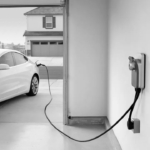Most EV drivers know that during these times of economic woes, our vehicle running costs are far less than those with gas drinking internal combustion engines.
But were you aware, it’s relatively easy to decrease EV charging costs even further?
Read on to discover some superb tricks that may even result in driving your EV for almost nothing, or at least make some significant reductions in cost.
1. Start Charger Sharing
In recent years, the emergence of community charging has increased in popularity, with the release of EV charging sharing apps specifically created for this purpose.
The concept is quite straightforward.
If you have a home EV charger, you rent it out to other EV drivers in return for a fixed fee per hour used.
By offering likeminded EV drivers a location to park and charge, you’re not only helping to close the gaps in public charging infrastructure, you’re also bringing in additional income.
This will undoubtedly cover the expense of any energy used, plus profit on top.
2. Change Energy Tariff
If you have your own residential parking, charging at home is easily the most economical way to top up.
A number of providers now sell home energy tariffs specifically geared towards EV owners who want to refuel their cars at home.
These tariffs offer significantly reduced overnight rates, when demand on the grid is at its least.
By switching, you can hook up your EV and top up overnight for a fraction of the cost compared to day rates.
You’ll also enjoy a fully charged car ready to go every morning before the daily school run.
Reach out to your current energy supplier to find out if they have any promotions.
If not, you can always move to a different supplier who does.
3. Free Public Chargers
Many EV drivers are unaware there’s a sizable number of public places to charge your car for free.
Presently, there’s said to be somewhere in the region of 5,000 free public EV chargers in the UK alone.
That amounts to approximately 15% of all public EV chargers.
So there’s plenty to go round.
Next time you’re driving, take a look at some of the chargepoint fees in locations like grocery stores and big brand shops.
Many are free of charge. So during your errands, you can charge your battery.
4. Don’t Use Rapid Chargers
Whilst rapid charging may seem attractive, occasionally it can be super expensive.
With energy costs now soaring, most public charging schemes have upped their fees, some by as much as 20% since September 2021.
So what was once an easy way to recharge and go, has now become fairly costly in comparison to home charging.
The general rule is, the less time it requires to refuel your car, the more it costs, mostly on main roads and motorways.
Ionity charger for example, operates some of the speediest rapid chargers in the nation (up to 350kW).
But their costs are typically expensive, costing around £0.69p per kilowatt hour (kWh).
On the contrary, Connected Kerb, which has slower on-street chargers, costs almost half that at £0.35p per kilowatt hour.
So if you’re not in a hurry, ponder using some of the slower rate public charging networks instead.
5. Drive Less Aggressively
If you have a keen right foot, now should be the time to just release the loud pedal a bit.
Just like petrol or diesel engined vehicles, the faster you drive, the more energy you burn.
Most modern EV’s utilise KERS (Kinetic energy recovery system) technology, so by easing off once in a while, you can maximise battery life.
Coasting when nearing junctions, lifting off to steadily reduce speed instead of heavy braking, and just driving at a more leisurely pace will give you even more range.
And if your EV has an ‘Eco’ mode, use it.
This will improve range by throttling the available power, and optimise electric consumption.
Also, disable the air conditioning if outside temperatures don’t demand it.
Whether your vehicle needs to produce hot or cooler air, this all demands electricity from the battery.
So if it’s a hot day, open the window a bit. If it’s slightly chillier than usual, wear an extra jumper or two.
Summary
With energy prices increasing and no sign of coming down any time in the future, we all must find solutions to optimise EV battery range and reduce running expenses.
By following some of the tricks in this article, you’ll unquestionably lower your EV charging expenses and in some situations, may even make a few extra pennies as well.





